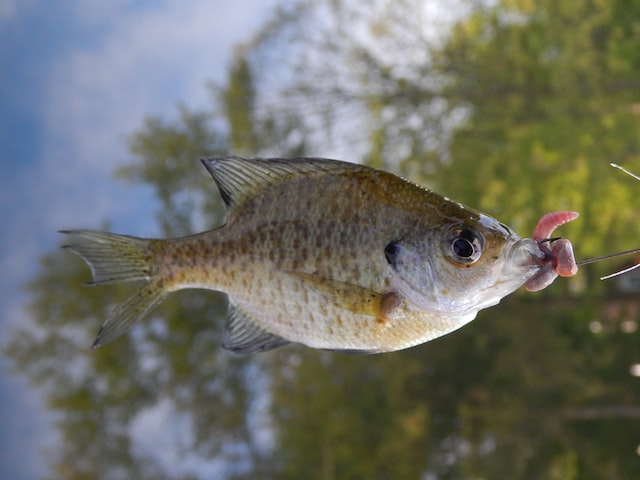When you’re fishing for fish, you might be wondering, “Are bluegill healthy to eat?” The answer is both yes and no. Bluegill have sharp spines that cover them top and bottom. These spines are there to protect them from predators, but they don’t make them poisonous. Bluegill are a good source of lean protein and can be cooked on the bone. Crappie, on the other hand, is much healthier than bluegill.
Raw bluegill is a good source of lean protein
The bluegill is a delicious and nutritious source of lean protein. Its 97 calories per three ounce serving is lower than those of chicken or red meat, and it contains little fat. Even the fat in bluegill is filled with Omega 3 fatty acids that fight inflammation, reduce blood pressure and help lower the risk of heart disease. Bluegill are native to the east coast of North America and are difficult to find on the west coast.
Bluegills are commonly caught freshwater fish and are a great addition to any camping trip. They’re easy to catch, fillet easily, and cook well over an open fire. They’re also mild-tasting and will not overwhelm your taste buds. Despite their mild flavor, bluegills make a great snack for a camping trip. You can even make them into sushi!
When cooking bluegill, make sure to cook them in fresh water, as these have the best taste. Clean the fish well before cooking it to remove any scales or skin. If you’re cooking over a hot flame, you can grill the fish on a stick or use a barbecue. Make sure to clean the fish thoroughly, but remember to eat the fins, as they are loaded with calcium and other nutrients.
One ounce of bluegill is rich in iron. It contains seven percent of your daily recommended allowance of iron. Another nutrient is Vitamin B-12. Three bluegills contain approximately 33% of the recommended daily intake of Vitamin B-12. These nutrients are important for healthy eating. Bluegills are an excellent source of lean protein and are an excellent source of Vitamin B-12.
Bluegill is a sunfish native to lakes and rivers. This fish can weigh up to four pounds and is among the most tastiest of all freshwater fish. Their mild flavor and flaky meat makes them a tasty treat. Despite their lack of finned appearance, bluegills are bottom feeders, so it’s a great option for anyone who doesn’t like a fishy taste.
Cooking it on the bone improves the flavor
There are many benefits to cooking bluegill on the bone. First, the fish will have more flavor. Secondly, the fish will be tender and less likely to fall apart. Cooking bluegill on the bone will also keep the tail and skin intact. This method of cooking the fish is especially good for young diners who may have difficulty handling bones. You can purchase a boneless fillet and fry it in a saucepan with 350 degrees peanut oil.
Lastly, cooking bluegill on the bone will give it a more unique flavor. The fish has a fishy flavor and pairs well with grits and hominy. You can even fry the fins, which taste similar to bacon. If you’re a fan of smoked pork shoulder, you should also try the tail and fin. These parts can be quite flavorful.
Bluegill is also one of the most popular eating fishes. They’re the meatiest panfish, making them a great snack for daytime meals. Some people believe that the best tasting fish comes from the ice hole. This is backed by a lot of scientific evidence. The most popular bluegill dish is fried bluegill. Bluegills can be baked, fried, broiled, or grilled. You can also choose to serve it whole.
Bluegill are often considered to be a low-priced option for family dinners. However, they have limited meat compared to their larger cousins, so it’s not worth the hassle of processing them. And because they’re small in size, you can’t expect to serve a small filet. Cooking bluegill on the bone also makes the fish more tender and juicy.
Another popular method is frying. When you’re frying, heat a large skillet over medium-high heat. Before cooking the bluegill, remove the scales and guts. Season the fillets with salt and pepper. Depending on their size, you can cook bluegill for approximately three minutes per side. Once the fish is cooked, you can serve them with lemon or tartar sauce.
The flavor of bluegill depends on how it’s prepared. The meat of bluegills is naturally flaky and has a mild fishy flavor. Unlike other freshwater species, they are easier to cook on the bone. Cooking bluegill on the bone will improve the taste and add to the overall presentation. It won’t impress anyone if you’re not careful when cooking bluegill.
Crappie is healthier than bluegill
When it comes to eating fish, the main difference between bluegill and crappie is the meat. Bluegill is more dense, while crappie meat is softer. Crappie meat falls apart easily during deep-frying. It is also prone to over-cooking, so it is best to keep it on ice to keep it from falling apart. While bluegill’s meat has a distinctive taste, crappie is not.
While both are good choices for eating, some people may find crappie healthier to eat. Crappie is richer in omega-3 fatty acids and B vitamins than bluegill. In fact, crappie has about 85% more omega-3 fatty acids than bluegill. Bluegill is also rich in minerals, zinc, selenium, and iron. They are also easier to catch and fillet than bluegill, but they are not as nutritious.
Bluegill and crappie have similar levels of mercury. They are both listed as a “best choice” fish by the Food and Drug Administration, but the FDA warns against consuming either of these fish in excess. Nevertheless, you may want to consult a doctor before eating any type of fish, especially if you’re pregnant. And, remember, the warnings about mercury and bluegill fish vary by state and area.
While bluegill and crappie have similar bodies, the two fish are actually quite different in size and nutritional content. The bluegill, also known as bream, can grow to 12 inches in length and weigh up to four-and-a-half pounds, while crappie are typically a little smaller. Despite this, they share similar habitats, which means they may overpopulate small ponds.
The main difference between crappie and bluegill is the color. Bluegills are much more colorful than crappie. Their blue gill covers make them easy to identify. Bluegills have orange fins and a darker belly. The difference in color between bluegills and crappie lies in their physiology and color. Bluegills have darker gills than crappie, but bluegills are generally healthier than crappie.
However, while Bluegill is more nutritious, crappie is larger. Crappie can grow to nine inches in length, while bluegill rarely reaches double digits. Many anglers say that Bluegill is the more nutritious fish, but Crappie is said to taste better than Bluegill because of its soft meat. A healthy diet is a good idea for a healthy life!
When you choose between bluegill and crappie as your favorite panfish, remember that bluegill is much healthier than crappie. Both fish can be eaten, with the right seasoning, but bluegill has a much better flavor. However, while bluegill is more nutritious, it’s not a great choice for those who are trying to stay healthy. A three-ounce portion of bluegill contains 97 calories, which is low in fat, carbohydrates, and cholesterol.









